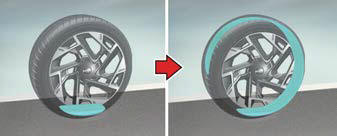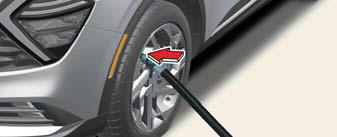Kia Sportage: Distributing the sealant

- Immediately drive approximately 4 ~ 6 miles (7 ~ 10 km or, about 10min) to evenly distribute the sealant in the tire.
CAUTION
Do not exceed a speed of 50 mph (80 km/h). If possible, do not fall below a speed of 12 mph (20 km/h).
While driving, if you experience any unusual vibration, ride disturbance or noise, reduce your speed and drive with caution until you can safely pull off of the side of the road. Call for road side service or towing.
When you use the Tire Mobility Kit, the wheel may be stained by sealant. Therefore, remove the wheel stained by sealant and have the vehicle inspected at an authorized Kia dealer.
Checking the tire inflation pressure
- After driving approximately 4 ~ 6 miles (7 ~ 10 km or about 10 min), stop at a safety location.
- Connect the filling hose of the compressor directly to the tire valve.

- Connect between compressor and the vehicle power outlet using the cable and connectors.
- Adjust the tire inflation pressure to the
recommended tire inflation.
With the ignition switched on, proceed as follows.
- To increase the inflation pressure: Switch on the compressor. To check the current inflation pressure setting, briefly switch off the compressor.
- To reduce the inflation pressure: Turn the valve on the compressor.
WARNING
Do not let the compressor run for more than 10 minutes, otherwise the device will overheat and may be damaged.
CAUTION
If the inflation pressure is not maintained, drive the vehicle a second time, refer to "Distributing the sealant". Then repeat steps 1 to 4.
Use of the TMK may be ineffectual for tire damage larger than approximately 0.16 of an inch (4 mm).
We recommend that you please contact the nearest Kia dealership if the tire cannot be made roadworthy with the Tire Mobility Kit.
WARNING
The tire inflation pressure must be at least 180 kPa (26 psi). If it is not, do not continue driving. Call for road side service or towing.
NOTICE
When reinstalling the repaired or replaced tire and wheel on the vehicle, tighten the wheel lug nut to 79 ~ 94 lbf*ft (11 ~ 13 kgf*m).
Notes on the safe use of the Tire Mobility Kit
- Park your car at the side of the road so that you can work with the TMK away from moving traffic. Place your warning triangle in a prominent place to make passing vehicles aware of your location.
- To be sure your vehicle will not move, even when you're on fairly level ground, always set your parking brake.
- Only use the TMK for sealing/inflation passenger car tires. Do not use on motorcycles, bicycles or any other type of tires.
- Do not remove any foreign objectssuch as nails or screws -that have penetrated the tire.
- Before using the TMK, read the precautionary advice printed on the sealant bottle!
- Provided the car is outdoors, leave the engine running. Otherwise operating the compressor may eventually drain the car battery.
- Never leave the TMK unattended while it is being used.
- Do not leave the compressor running for more than 10 min. at a time or it may overheat.
- Do not use the TMK if the ambient temperature is below -22ºF (-30ºC).
- When the tire and wheel are damaged, do not use Tire Mobility Kit for your safety.
Technical Data
- System voltage: DC 12 V
- Working voltage: DC 12 V
- Amperage rating: max. 15 A
- Suitable for use at temperatures: -22 to 158 ºF (-30 to 70 ºC)
- Max. working pressure: 101 psi (7 bar)
- Size
- Compressor: 150 x 130 x 60 mm (5.9 x 5.1 x 2.4 in.)
- Sealant bottle: 115.3 x 87.3 ø mm (4.5 x 3.4 ø in.)
- Compressor weight: 620 g (1.36 lbs)
- Sealant volume: 400 ml (24.4 cu.in.)
* Sealant and spare parts can be obtained and replaced at an authorized vehicle or tire dealer. Empty sealant bottles may be disposed of at home. Liquid residue from the sealant should be disposed of by your vehicle or tire dealer or in accordance with local waste disposal regulations.
READ NEXT:
 Jack and tools
Jack and tools
If you have a flat tire, you can change
the flat tire to a spare tire using tools.
WARNING
Driving on a flat tire will cause permanent
damage to the tire. Re-inflating a
tire after it has been dr
 Changing tires
Changing tires
WARNING
A vehicle can slip or roll off of a jack
causing serious injury or death to you or
those nearby. Take the following safety
precautions:
Never place any portion of your body
under a v
SEE MORE:
 Side Airbag (SAB) Module | Curtain Airbag (CAB) Module
Side Airbag (SAB) Module | Curtain Airbag (CAB) Module
Description and Operation
Description
The Side Airbags (SAB) are installed inside the front seat and protects the driver and passenger from danger when side crash occurs. The SRSCM determines deployment of side airbag by using Side Impact Sensor (SIS) signal.
CAUTION
Never attempt to mea
 Installing a CRS
Installing a CRS
After selecting a proper child seat for
your child, check to make sure it fits
properly in your vehicle.
Follow the instructions provided by the
manufacturer when installing the child
seat. Note these general steps when
installing the seat to your vehicle:
Properly secure the child restr
Content
- Home
- Kia Sportage - Fifth generation (NQ5) - (2022-2025) - Owner's Manual
- Kia Sportage - Second generation (JEKM) (2005-2015) - Body Workshop Manual
- Kia Sportage Third generation (SL) - (2011-2016) - Service and Repair Manual
- Sitemap
- Top articles